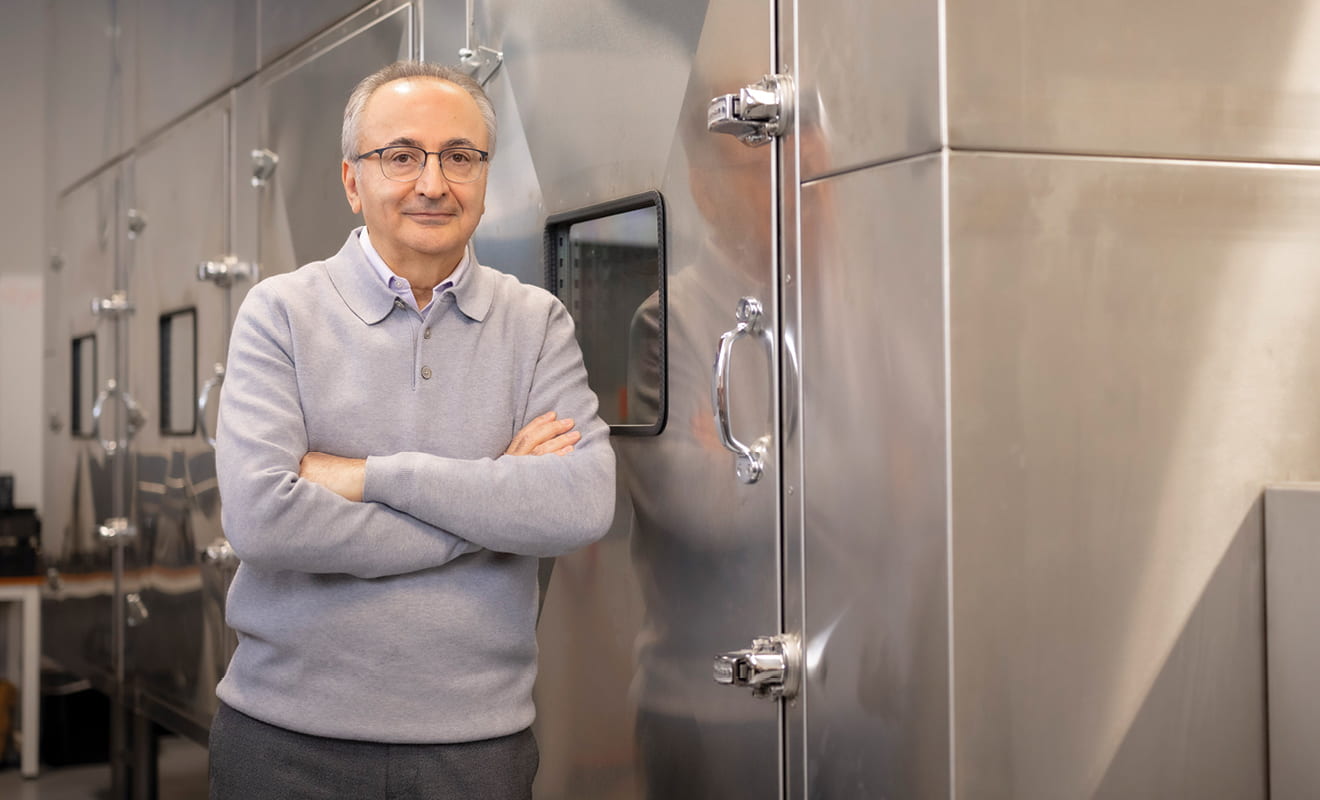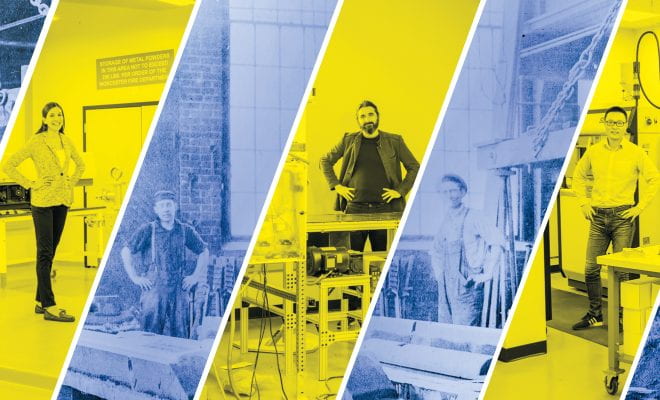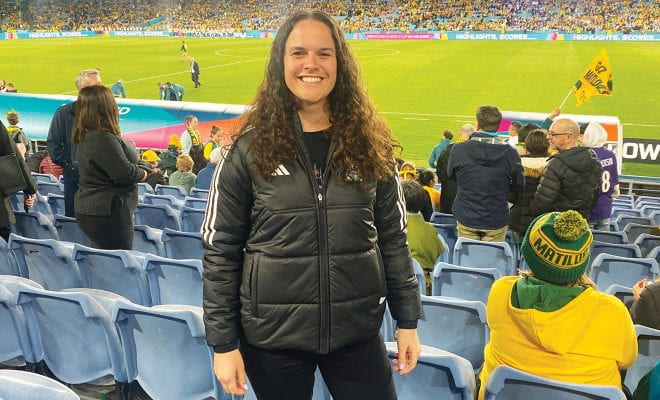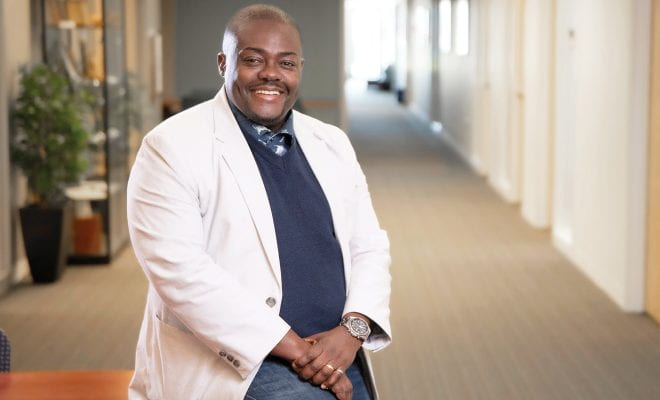Jamal Yagoobi has two areas of expertise, and both involve heat—more specifically, the theoretical, numerical, and experimental study of heat transfer and mass transport enhancement. One area helps keep electronic equipment from overheating in space; the other addresses the energy-hogging drying process in the large-scale manufacturing of items such as food, paper, and chemical products.
As a result, the George F. Fuller Professor of Mechanical and Materials Engineering can find his innovative technologies in places as exciting as the International Space Station or as ordinary as a snack food manufacturing plant.
“Although these two areas may seem to be very different, they’re based on a common technical platform,” he says. “Drying deals with the heat and mass transfer in moist porous media while the cooling of electronics is concerned with liquid/vapor phase change in the presence and absence of gravity.”
In addition to being technically complex, Yagoobi’s research considers heat transfer at a large scale. “Picture a football field–sized oven that dries or bakes dough that will eventually be snacks, or pulp that will end up as packaging,” he says. “This is the scale of industrial drying. The processes that companies use are mostly decades old and the U.S. Department of Energy estimates that almost half of this energy use is wasted. Industry needs new technologies.”
Heat is also a concern aboard spacecraft. Without proper cooling, the heat generated by electronic equipment can damage critically important equipment or harm astronauts. Innovative non-mechanical heat transfer technologies are crucial for the success of next-generation satellites or deep space missions.
Both areas of Yagoobi’s research have gotten attention and support from academia, government, and industry over the course of his career. He has received funding from NASA each year for more than 30 years, as well as from the National Science Foundation, Air Force Office of Scientific Research, Department of Energy, Massachusetts Clean Energy Center, and various industry sources. Fellowships and consulting projects have taken him around the world, and he holds 10 patents along with four provisional patents. Previously head of the Mechanical and Materials Engineering Department for 11 years, he is also the founding director of the National Science Foundation–funded Center for Advanced Research in Drying (CARD), the first North American research center dedicated solely to studying industrial drying.
When Yagoobi was in the fifth grade, his teacher asked members of his class to write essays about what they wanted to be when they grew up. For him, the assignment was easy. He would explore space—somehow, some way. Even as he grew older, his interest in space didn’t wane. “I had such a keen interest,” he says. “I went through everything in the local bookstore and even subscribed to magazines about space.”
From his hometown of Tabriz, Iran, a 14-year-old Yagoobi wrote to one such magazine, asking how he could pursue a career that would allow him to investigate the many mysteries of the universe. The answer came back: study physics or engineering. He chose engineering and began a journey that would take him from Sharif University of Technology in Tehran to the University of Illinois in Urbana-Champaign, to WPI—and even to NASA’s zero-gravity aircraft.
As a graduate student at the University of Illinois, he studied mechanical engineering, which led to a postgraduate fellowship at NASA’s Goddard Space Flight Center. These days, he and his research team are in regular contact with Goddard as well as Glenn Research Center scientists and collaborate on the development of cooling technologies that function in the absence of gravity.
“That was a great experience,” Yagoobi says, reflecting on the Zero-G flight. “You really rise up from the floor! I’m grateful that my students and I had that opportunity. More important, we got to conduct important experiments—we also tested the technology with moon and Mars gravity. We’re proud of what we developed and are confident the technology will be used in next-generation satellites as well as long missions by NASA. It also has terrestrial applications in industrial cooling and heating, ventilation, air conditioning, and refrigeration systems.”
While Yagoobi’s interest in space tech can be traced to his childhood dreams, his work on industrial drying developed from his work experience after receiving his doctorate.
“I didn’t know much about drying until I worked in industry after graduating,” he says of the three years he worked at Westvaco, a pulp and paper company. “That’s where I began to appreciate the importance of drying, the amount of energy it uses, and how much work we can do to reduce our carbon footprint. I decided to return to academia and focus on this challenge.”
Yagoobi’s work in this area has established him as a national leader whose technological advancements are in demand by industries looking to reduce their energy usage and carbon footprint.
As the founding director of CARD, which was established in 2016, Yagoobi leads a team of faculty and graduate and undergraduate students from WPI and the University of Illinois in Urbana-Champaign. As one of NSF’s Industry University Cooperative Research Centers, CARD facilitates close cooperation between academic researchers and industry partners. Companies such as BASF, Mondelez International, and PepsiCo have partnered with CARD.
Yagoobi’s research has major implications for the nation’s energy and sustainability goals. Industrial drying, particularly in the food, paper, and chemicals industries, accounts for about 1.2% of this country’s total energy consumption. “U.S. companies are mandated to have a zero-carbon footprint by 2050. CARD will play a critical role in helping meet that goal even earlier than that,” he says.
CARD researchers have developed a dielectrophoretic drying technology that extracts vapor from moist material, and airborne ultrasonic dehydration process that removes moisture with ultrasonic waves. They are also working on the use of fiber optics to detect information about moisture in porous materials, which may lead to more precise measurements and efficient drying. Artificial intelligence also plays a role in CARD projects—researchers can simulate various drying processes to determine the optimal processes for different materials. With simulation, numerical calculations, and experimental data, CARD research can minimize energy consumption while also improving product quality.
Yagoobi is particularly proud of the development of slot jet reattachment nozzle technology, which improves convective heating and reduces natural gas consumption, and ultrasound-assisted radial jet reattachment nozzle atomizer technology, which significantly reduces energy usage in processes such as liquid evaporation or atomization.
CARD has licensed this atomizer technology to Bright Feeds, a company that converts food waste to animal feed.
“One-third of food produced in the U.S. is wasted,” Yagoobi says. “Imagine the carbon footprint created by producing that food, and then that food is wasted! If we can convert that waste to animal food with minimal energy consumption, the impact on the environment is huge.”
Yagoobi’s research on heat transfer and industrial drying has drawn two major conferences to Worcester, with researchers coming from around the world to WPI’s campus. The International Drying Symposium (IDS), founded in 1978, brings together world-renowned researchers and engineers from academia and industry. It’s the most important event for scholars who study drying.
“The last IDS held on U.S. soil was in 1986 at MIT’s campus. I was successful in bringing IDS back to the United States in 2022,” Yagoobi says. “I’m so grateful to WPI for providing the space and showcasing our beautiful campus. We were able to highlight CARD’s impact on the field.”
WPI was in the spotlight again in the summer of 2023, when Yagoobi chaired the Institute of Electrical and Electronics Engineers (IEEE) International Conference on Dielectric Liquids on campus. The forum, which included participants from 18 countries, had never been held in the United States.
“Conferences like these improve the image and reputation of WPI globally,” he says. “By hosting these international events, we become known as leaders in the field.”
Worcester is also home to research breakthroughs, thanks to work Yagoobi and colleagues conduct at the Advanced Manufacturing Center, which opened in 2021 in a former manufacturing building near WPI’s campus. The new space accommodates a technology that came to Yagoobi’s mind during a run—when many of his ideas come to him, he says.
“I’m not a fast runner, but I very much enjoy it,” he says. “During one of my runs, I wondered if I could design a dryer with various technologies, one that could help industries by testing different methods and gathering scalable data.”
After some more thinking and $3.5 million in funding from the U.S. Department of Energy, plus support from the Massachusetts Clean Energy Center and CARD member Reading Bakery Systems, the smart dryer testbed became a reality. Coming in at 10 meters long and equipped with a conveyer belt and custom sensors (developed by his colleagues Associate Professor Yuxiang Liu, mechanical and materials engineering, and Professor Doug Petkie, physics, and their students), the testbed includes technologies such as airborne ultrasonic drying, slot jet reattachment nozzle technology, infrared technology, and dielectrophoretic dehydration technology.
“This testbed, widely used by industry partners, is for food, paper, chemicals, you name it,” Yagoobi says. “We can easily change the location of these technologies. So, for a given product, we determine the optimal combination and operating conditions. It’s quite novel—there’s nothing similar to it in the world.”
In addition to testing drying methods that industries can implement to lower their energy usage, he intends to use the testbed as a teaching tool for graduate and undergraduate students.
Yagoobi knows that listening to a lecture can be challenging, and it’s also not the best way to develop a deep, nuanced understanding of complex topics. In his classes, he looks for ways to interrupt lectures with opportunities for interaction. That might mean inviting a student to the front of the room to explain a concept, or simply pausing to ask a question. He gives students a heads-up that his class functions this way and offers the chance to opt out, but most students want to participate.
“Showing the testbed to students who aren’t necessarily doing research themselves lets them see how research is done and how it’s relevant to the classroom material,” he says. “We all daydream when we sit in a meeting, right? I try to create a collaborative environment, so that students stay engaged.”
Students who do engage in research with Yagoobi get fundamental understanding as well as hands-on experiences—the zero-gravity experience being the most exciting example—in addition to receiving mentorship from partner industries and seeing how experimental technology is actually used in manufacturing plants.
One experiment from Yagoobi’s lab soon will be flying into space and will bear a logo designed by a former student Michal Talmor Tilley, PhD ’23, who passed away in 2021 while working on her dissertation. After her death, Yagoobi took it upon himself to complete her dissertation on electrohydrodynamics.
Over the course of his career, Yagoobi has supervised upwards of 100 other students as they complete their doctoral dissertations and master’s theses, both at institutions where he has worked and at universities in France, Sweden, Morocco, and India. He’s also hosted more than 70 international students and scholars in his research laboratories at WPI, and at Illinois Institute of Technology-Chicago and Texas A&M University. He’s been recognized for his outstanding teaching and research by Texas A&M; for his research by the American Society of Mechanical Engineers (ASME), IEEE, and NASA; and for his collaborative work by the French Ministry of Education. He is a fellow of ASME and IEEE and has published 335 articles in lead journals, conference proceedings, and book chapters.
“Teaching is interactive and interesting to me,” Yagoobi says. “I don’t look at it as a distraction from my research—absolutely not. In fact, so much of research is teaching. I really love teaching, going into the classroom, and interacting with students.”
In the future, he hopes to add additional technologies, such as microwave, radio frequency, laser, and induction heating to the smart dryer testbed at WPI. He’s also working on making heat pump technology more efficient by adding electrohydrodynamic technology, something he calls “really, really exciting.” And there is more to be done in the world of heat pumps, as he works to develop one that can operate at higher temperatures and with reduced energy consumption. For this project, he says, he is “merging my two research hats.”
Ultimately, Yagoobi says, he will continue pushing his research interests forward, keep teaching, keep collaborating, keep musing on heat transfer and energy consumption during his runs, and see where it takes him, whether that’s to zero gravity or zero carbon emissions.











Reader Comments
0 Comments